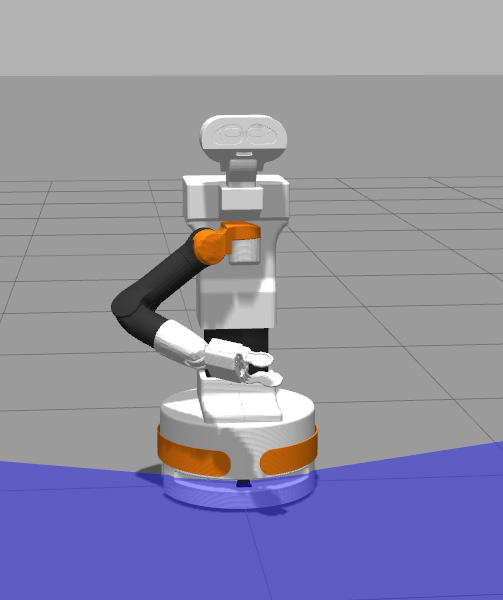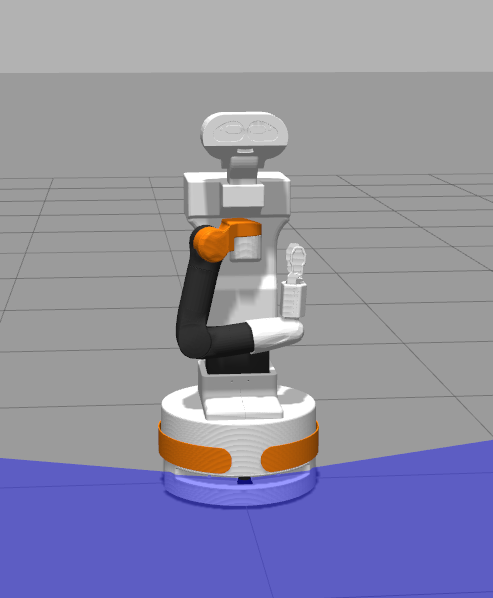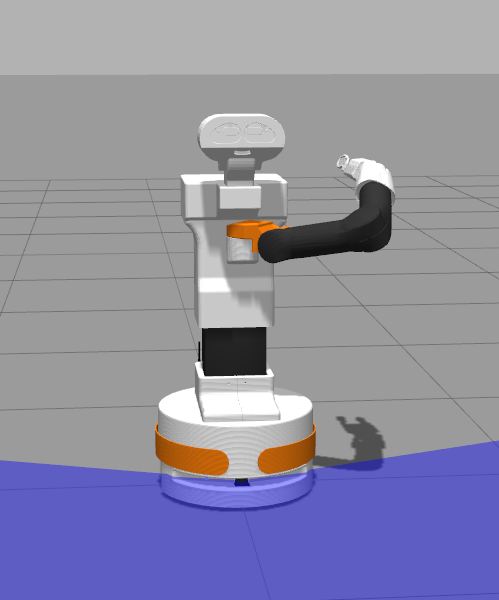Author: Alessandro Di Fava < alessandro.difava@pal-robotics.com >
Maintainer: Jordi Pages < jordi.pages@pal-robotics.com >, Alessandro Di Fava < alessandro.difava@pal-robotics.com >
Support: tiago-support@pal-robotics.com
Source: https://github.com/pal-robotics/tiago_tutorials.git
| |
Joint Trajectory Controller
Description: Example of how to move TIAGo's arm using a joint trajectory action.Keywords: joint, trajectory controller
Tutorial Level: BEGINNER
Next Tutorial: Moving individual joints

Contents
Purpose
This tutorial shows how to use the joint_trajectory_controller to move the arm of TIAGo. The action can be used to give a trajectory to the arm expressed in several waypoints.
Pre-requisites
First make sure that the tutorials are properly installed along with the TIAGo simulation, as shown in the Tutorials Installation Section.
Available interfaces
There are two mechanisms for sending trajectories to the controller, as written in joint_trajectory_controller. By means of the action interface or the topic interface. Both use the trajectory_msgs/JointTrajectory message to specify trajectories.
For the TIAGo the following interfaces are available: torso control, head control, arm control. The following interfaces are used.
Torso controller
The torso prismatic joint can be controlled with the following joint trajectory interfaces:
/torso_controller/command (trajectory_msgs/JointTrajectory)
- Topic interface to move the torso lifter
- Action interface to move the torso lifter
Head controller
The 2 joints of the head can be controlled defining trajectories using the following interfaces:
/head_controller/command (trajectory_msgs/JointTrajectory)
- Topic interface to move the head
- Action interface to move the head
Arm controller
Trajectories for the 7 joints of the arm can be controlled using the following interfaces:
/arm_controller/command (trajectory_msgs/JointTrajectory)
- Topic interface to move the arm
- Action interface to move the arm
Hey5 hand controller
For the titanium version of TIAGo the hand control interface is also available:
/hand_controller/command (trajectory_msgs/JointTrajectory)
- Topic interface to move the 3 motors of the Hey5 hand.
- Action interface to move the 3 motors of the Hey5 hand.
Gripper controller
For the steel version of TIAGo the gripper control interface is available:
/parallel_gripper_controller/command (trajectory_msgs/JointTrajectory)
- Topic interface to move the parallel gripper virtual joint, i.e. to control the separation of the fingers.
- Action interface to control the separation of the fingers of the gripper
- Topic interface to move the 2 motors of the gripper, i.e. each finger, individually.
Execution
Open two consoles and source the public simulation workspace as follows:
cd /tiago_public_ws/ source ./devel/setup.bash
Launching the simulation
In the first console launch for example the following simulation
roslaunch tiago_gazebo tiago_gazebo.launch public_sim:=true end_effector:=pal-gripper world:=empty
Gazebo will show up with TIAGo in an empty world.

Wait until TIAGo has tucked its arm. Then you may proceed with the next steps.
Launching the nodes
Now we are going to run an example with two waypoints that will bring TIAGO to the following joint space configurations of the arm. First waypoint:
arm_1_joint: 0.2 arm_2_joint: 0.0 arm_3_joint: -1.5 arm_4_joint: 1.94 arm_5_joint: -1.57 arm_6_joint: -0.5 arm_7_joint: 0.0
Second waypoint:
arm_1_joint: 2.5 arm_2_joint: 0.2 arm_3_joint: -2.1 arm_4_joint: 1.9 arm_5_joint: 1.0 arm_6_joint: -0.5 arm_7_joint: 0.0
The node that will take care to execute the set of waypoints to reach such a kinematic configuration is run_traj_control included in tiago_trajectory_controller package and has to be called as follows
rosrun tiago_trajectory_controller run_traj_control
An example of plan executed by the node is depicted in the following sequence of images:
|
|
|
Inspecting the code
The code to implement such a node is shown below. Note that the key parts of the code are:
- Create an arm controller action client
- Wait for arm controller action server to come up
- Generates a simple trajectory with two waypoints (goal)
- Sends the command to start the given trajectory
- Give time for trajectory execution
1 // C++ standard headers 2 #include <exception> 3 #include <string> 4 5 // Boost headers 6 #include <boost/shared_ptr.hpp> 7 8 // ROS headers 9 #include <ros/ros.h> 10 #include <actionlib/client/simple_action_client.h> 11 #include <control_msgs/FollowJointTrajectoryAction.h> 12 #include <ros/topic.h> 13 14 15 // Our Action interface type for moving TIAGo's head, provided as a typedef for convenience 16 typedef actionlib::SimpleActionClient<control_msgs::FollowJointTrajectoryAction> arm_control_client; 17 typedef boost::shared_ptr< arm_control_client> arm_control_client_Ptr; 18 19 20 // Create a ROS action client to move TIAGo's arm 21 void createArmClient(arm_control_client_Ptr& actionClient) 22 { 23 ROS_INFO("Creating action client to arm controller ..."); 24 25 actionClient.reset( new arm_control_client("/arm_controller/follow_joint_trajectory") ); 26 27 int iterations = 0, max_iterations = 3; 28 // Wait for arm controller action server to come up 29 while( !actionClient->waitForServer(ros::Duration(2.0)) && ros::ok() && iterations < max_iterations ) 30 { 31 ROS_DEBUG("Waiting for the arm_controller_action server to come up"); 32 ++iterations; 33 } 34 35 if ( iterations == max_iterations ) 36 throw std::runtime_error("Error in createArmClient: arm controller action server not available"); 37 } 38 39 40 // Generates a simple trajectory with two waypoints to move TIAGo's arm 41 void waypoints_arm_goal(control_msgs::FollowJointTrajectoryGoal& goal) 42 { 43 // The joint names, which apply to all waypoints 44 goal.trajectory.joint_names.push_back("arm_1_joint"); 45 goal.trajectory.joint_names.push_back("arm_2_joint"); 46 goal.trajectory.joint_names.push_back("arm_3_joint"); 47 goal.trajectory.joint_names.push_back("arm_4_joint"); 48 goal.trajectory.joint_names.push_back("arm_5_joint"); 49 goal.trajectory.joint_names.push_back("arm_6_joint"); 50 goal.trajectory.joint_names.push_back("arm_7_joint"); 51 52 // Two waypoints in this goal trajectory 53 goal.trajectory.points.resize(2); 54 55 // First trajectory point 56 // Positions 57 int index = 0; 58 goal.trajectory.points[index].positions.resize(7); 59 goal.trajectory.points[index].positions[0] = 0.2; 60 goal.trajectory.points[index].positions[1] = 0.0; 61 goal.trajectory.points[index].positions[2] = -1.5; 62 goal.trajectory.points[index].positions[3] = 1.94; 63 goal.trajectory.points[index].positions[4] = -1.57; 64 goal.trajectory.points[index].positions[5] = -0.5; 65 goal.trajectory.points[index].positions[6] = 0.0; 66 // Velocities 67 goal.trajectory.points[index].velocities.resize(7); 68 for (int j = 0; j < 7; ++j) 69 { 70 goal.trajectory.points[index].velocities[j] = 1.0; 71 } 72 // To be reached 2 second after starting along the trajectory 73 goal.trajectory.points[index].time_from_start = ros::Duration(2.0); 74 75 // Second trajectory point 76 // Positions 77 index += 1; 78 goal.trajectory.points[index].positions.resize(7); 79 goal.trajectory.points[index].positions[0] = 2.5; 80 goal.trajectory.points[index].positions[1] = 0.2; 81 goal.trajectory.points[index].positions[2] = -2.1; 82 goal.trajectory.points[index].positions[3] = 1.9; 83 goal.trajectory.points[index].positions[4] = 1.0; 84 goal.trajectory.points[index].positions[5] = -0.5; 85 goal.trajectory.points[index].positions[6] = 0.0; 86 // Velocities 87 goal.trajectory.points[index].velocities.resize(7); 88 for (int j = 0; j < 7; ++j) 89 { 90 goal.trajectory.points[index].velocities[j] = 0.0; 91 } 92 // To be reached 4 seconds after starting along the trajectory 93 goal.trajectory.points[index].time_from_start = ros::Duration(4.0); 94 } 95 96 97 // Entry point 98 int main(int argc, char** argv) 99 { 100 // Init the ROS node 101 ros::init(argc, argv, "run_traj_control"); 102 103 ROS_INFO("Starting run_traj_control application ..."); 104 105 // Precondition: Valid clock 106 ros::NodeHandle nh; 107 if (!ros::Time::waitForValid(ros::WallDuration(10.0))) // NOTE: Important when using simulated clock 108 { 109 ROS_FATAL("Timed-out waiting for valid time."); 110 return EXIT_FAILURE; 111 } 112 113 // Create an arm controller action client to move the TIAGo's arm 114 arm_control_client_Ptr ArmClient; 115 createArmClient(ArmClient); 116 117 // Generates the goal for the TIAGo's arm 118 control_msgs::FollowJointTrajectoryGoal arm_goal; 119 waypoints_arm_goal(arm_goal); 120 121 // Sends the command to start the given trajectory 1s from now 122 arm_goal.trajectory.header.stamp = ros::Time::now() + ros::Duration(1.0); 123 ArmClient->sendGoal(arm_goal); 124 125 // Wait for trajectory execution 126 while(!(ArmClient->getState().isDone()) && ros::ok()) 127 { 128 ros::Duration(4).sleep(); // sleep for four seconds 129 } 130 131 return EXIT_SUCCESS; 132 }
Note that for the first waypoint, for each joint in the trajectory, we use a velocity of 1.0 m/s. It specifies the velocity of the trajectory when reaching the waypoint. We obtain it with the following line of code
70 goal.trajectory.points[index].velocities[j] = 1.0;
As we want the robot to move smoothly when reaching the first target waypoint. By setting the velocity to 0.0 m/s will cause a step-wise movement, where the robot will stop in each waypoint. We set the velocity to 0.0 m/s just for the last waypoint.
The joint_trajectory_controller will map the position+velocity trajectory to position commands through a PID loop.
Joint trajectory messages allow to specify the time at which the trajectory should start executing by means of the header timestamp. In the following line of code, the node will start the given trajectory 1s from "now"
122 arm_goal.trajectory.header.stamp = ros::Time::now() + ros::Duration(1.0);
The required control commands are sent to the arm controller through the topic of their action interfaces:
/arm_controller/follow_joint_trajectory









